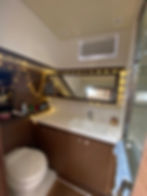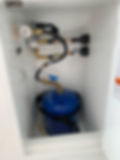Realities of Living on a Boat
- Christine
- Oct 16, 2021
- 7 min read
Updated: Nov 16, 2021
The key to living on a boat is teamwork! We each wear several hats on the boat and work together in keeping each other safe and the boat in ship shape. Given the size of the boat, we must each pitch in in order to make things happen.
Below are some normal daily activities that are done a bit differently on a boat:

Megan and Christine cooking and cleaning in calm seas.
Cooking in a Galley
Cooking while sailing commands excellent balance and a strong grip to brace yourself so you don’t ricochet between the stove and countertops.
The sun is so bright, Christine wears sunglasses while cooking, while Megan tries to maximize her tan.
Our stove has a metal frame around the cooktop where you can strategically place metal slats to prevent hot pots and pans from spilling over or sliding onto the floor inadvertently.
Drawer space is so minimal that we can barely fit our 2 sets of silverware in one drawer. It’s a challenge that not even the Container Store has been able to resolve.
Cabinet space is also at a premium (it’s about 1/10th of the cabinet space we have at home), so having a set of collapsable preparation bowls, salad spinner and strainer has been a huge space saver.
No dishwasher - one of my worst nightmares! But, I think the trade-off with having an air conditioner has been well worth it, as we have had many sweltering days and nights.
So we don’t starve, there are 3 small refrigerators on-board. Two are mainly for drinks (in the cockpit and galley) and a third one is located outside the master cabin for those midnight raids.

Master cabin with the typical odd-shaped bed.
Sleeping in Cabins (Bedrooms)
While anchored, the gentle rocking of our boat and the cool sea breeze blowing through our hatches insures a very peaceful and calm night of sleep. Occasionally, we are rudely awakened by an anchor alarm if our boat moves beyond set limits. So far we have never dragged anchor, but have rotated with the wind along with all of our boat neighbors.
Staying at a marina also insures a good night of sleep, as we don't need to listen for our anchor alarm, however, there is no rocking to sleep.
It's a challenge to sleep while sailing through the night in rougher seas, unless you are deaf. The sound of the waves hitting our hulls (where the cabins are) sounds like a car ramming full speed into a punch bag several times a minute. Occasionally, it actually feels like your mattress is being punched from under you, just as you finally fall asleep. While it may seem like a no-brainer to wear ear plugs, you could perhaps miss a sound that is even more disconcerting, but critical to address. Amazingly, Dale and Megan seem to be able to sleep through the crashing sounds and remain alert to any alarms that go off.
We have to remember to close all of our hatches in the ceiling while sailing through the night so we aren't doused by sea water.
All beds are a Queen/Double hybrid with an odd shape. The head of the bed is wider than a Queen bed and tapers to more of a Double bed width at the foot of the bed. Finding the right fitted sheets was impossible without having custom sheets made, which we didn’t go for at $500 a piece. So, there is a lot of “sheet” tucked at the foot of each bed.

Megan's head totally decked out.
Showering and Toileting in the Head (Bathroom )
Fortunately, all ensuite cabins are equipped with flushable toilets, so no need to pump out your waste.
Prior to every shower, we check our water gauge to ensure that there is enough water in our tank. The pump system could be damaged if we run the tank dry. Megan claims the shower water pressure is better than what she has at home.
Sometimes we just shower on our back deck (in our swimsuits), as we have a hand held shower, conveniently located off our swim out deck.
To conserve water, we turn the water on only for rinsing when showering.
Showering while the boat is underway requires maintaining yoga-like poses to insure you don’t slip and fall. If you get seasick easily, it is better to remain stinky and sweaty until the boat has stopped motoring or sailing.

Dale pumping iron while taking in the sunrise while sailing (thanks to autopilot).
Exercising
Only Dale has found a way to exercise on the boat. If we’re in a marina, he jogs around and scopes out all the good bakeries and fun places to visit. If we’re anchored, he will swim to a beach with his tennis shoes in a dry bag and then jog up the nearest mountain and back. He also has his weights and a yoga mat which he will use while under sail (we love our autopilot!). Being the social butterfly, he also enjoys paddle boarding around our anchorages to meet other boaters from all over Europe.
Our resident swimmer, Megan, will typically swim around the boat and to a beach and back, but she mostly likes to do back flips off the boat into the water.
Christine needs her tennis racket to exercise and since we have not spotted any tennis courts along the coast, she has pulled out the exercise mat exactly 3 times since we left.
She is secretly hoping that paddle boarding to the beach, pulling lines in and cranking the winch will keep her in shape along with the core workout she gets from keeping her balance while under way.

Our Swedish relative, Anna, helping spray the decks down while Megan scrubs the deck.
Swabbing the deck (and all the cushions)
After every sail, if there are any waves, it is inevitable that our boat get sprayed with sea water, leaving a nice, gritty, sticky residue everywhere. Torrential rain (at night) is always welcoming, as that seems to clean the boat nicely, except if it is one of those Sahara Desert rains which drop reddish sand all over our boat. We have lost count how many times we’ve had to wash our decks and cushions. All cushions are snapped down very securely to ensure they do not fly into the sea while underway, but it’s brutal on your fingers and knuckles each time it needs to be unfastened and refastened.
Washing the exterior of the boat takes a lot of patience and energy and must be done on a very calm day. We must stand, balanced in our rocky dinghy, cleat it to our boat and hand scrub a small section of the boat at a time before some one uncleats the line and moves the dinghy over another couple of feet, only to repeat the same process.

Megan at a laundromat in Lisbon patiently waiting for our wash to finish.
Laundry
Seems like a luxury to have a washer/dryer unit on board, but it is super tiny and the dryer uses water/steam to dry our clothes and takes several hours. We have given up on the dryer and hang our clothes on our life lines, outlining our deck and string lines across our cockpit, so we look like gypsies when we are doing laundry.
For larger loads, we trudge into town or a marina with our huge bags of laundry, lots of change in Euros and something to keep us occupied for several hours. So far, the most number of washers we have seen at a public laundromat is 3 with at most 2 dryers! There is always a wait, so laundry is often at least a half day affair, where we often hang out at a local coffee shop.
Dale and Megan participating in grocery marathon; Christine wonders where to store this all.
Grocery Shopping
Our go-to store is Carrefour, a French version of a Super Walmart, if we have the means to get there and back to our marina.
It’s interesting shopping in a foreign country when you have no idea what you are buying sometimes. We have had some surprises when we’ve opened up a can or package and gotten something unexpected.
Christine loves her translation app, as she types in what she can’t find in English and shows the Spanish translation to the grocery personnel.
Translating labels from Spanish to English works pretty well, though it's a bit disconcerting when what she thinks is grated parmesan cheese translates to "dust."
So far, we have not found sour cream or any decent cereals. It’s a bit pathetic to get excited when you finally see green onions, however, this has only happened once.
Since we never know if we’re going to find what we need in the next town, we always go crazy shopping when we are at Carrefour. We all split up at the grocery store to divide and conquer. At first, we would call each other with what we collected in our carts, but Megan has since set up a shared list for us to check off. Megan is happy to be our resident snack specialist and scout.
Local markets and farmer’s markets have also supplemented our food supply and have sometimes been our only source of food since some towns have no Uber or taxi service to transport us to a supermarket, further away.
Megan's secret stash. Storage under floorboard. Micro silverware drawer.
Galley Storage
Space is at a premium. The boat only has three drawers the width of the above silverware drawer and one cabinet with three shelves for all pots, pans, kitchen electronics, etc.
Have 4 under-floorboard storage lockers where we store staples and drinks. Finally can open these without scraping up our legs and have mastered squatting.
Megan emerging from engine room after switching water tanks. Water gauge for tank 1.
Water
There are two water tanks on board. One hull holds 500 L and the other one holds 250 L, since we sacrificed some space to accommodate a water maker on board. When we don’t have access to a marina or if we are sailing overnight, having a water maker on board is a life saver.
Of course if we are in a marina, we hook up to their water.
Hot water for showers or washing dishes is only available after we run the engines for a while, run the generator or if we’re hooked up to electricity at a marina. On the warmer days, we have found that cooler water is very refreshing.
Filtered water is available in our galley, as well as tap water.

Two of four solar panels. One is dedicated to Christine's hairdryer, which could not be left behind.
Electricity
We have a bank of 12V DC batteries that power most of the boat’s electronics and a 110V inverter that powers select items like the water maker, A/C and washing machine,
Power supply options includes shore power at marinas, engine alternators, generator and solar panels.
Solar panels provide a charge when we are not hooked up to shore power and/or are not running the generator. (I like the solar panels, as that allows me to run my blowdryer.)
Besides checking water levels, we are constantly making sure we have enough power to keep our appliances going.

The magic behind vodka pasta, risotto, broiled salmon, meatloaf & grilled chicken.
Gas
A gallon tank of propane powers our oven and stove for about 2.5 weeks.
Having a spare gallon tank of propane is a must, should we run out in the middle of the sea while baking pork tenderloin, which is exactly what happened to us.
.png)













